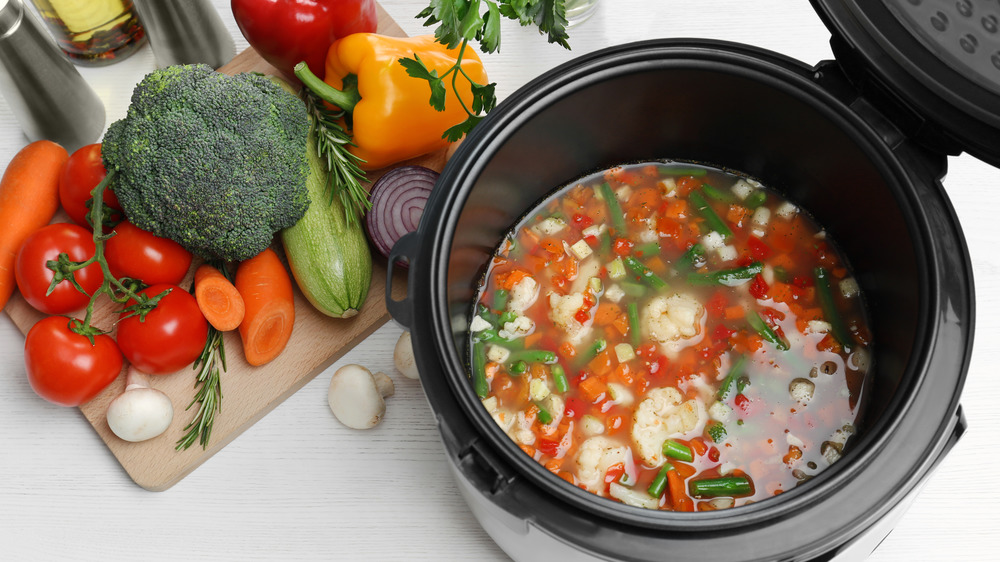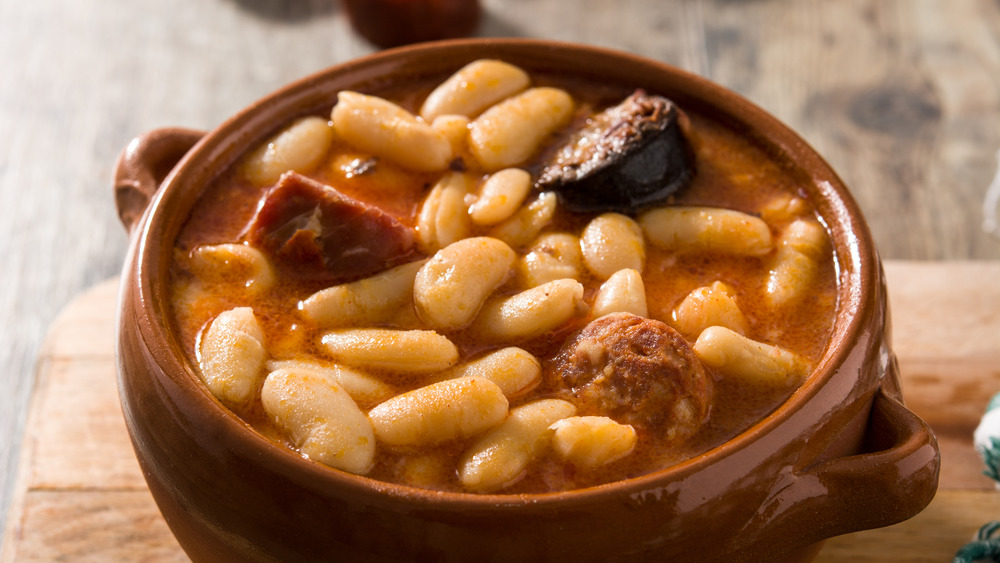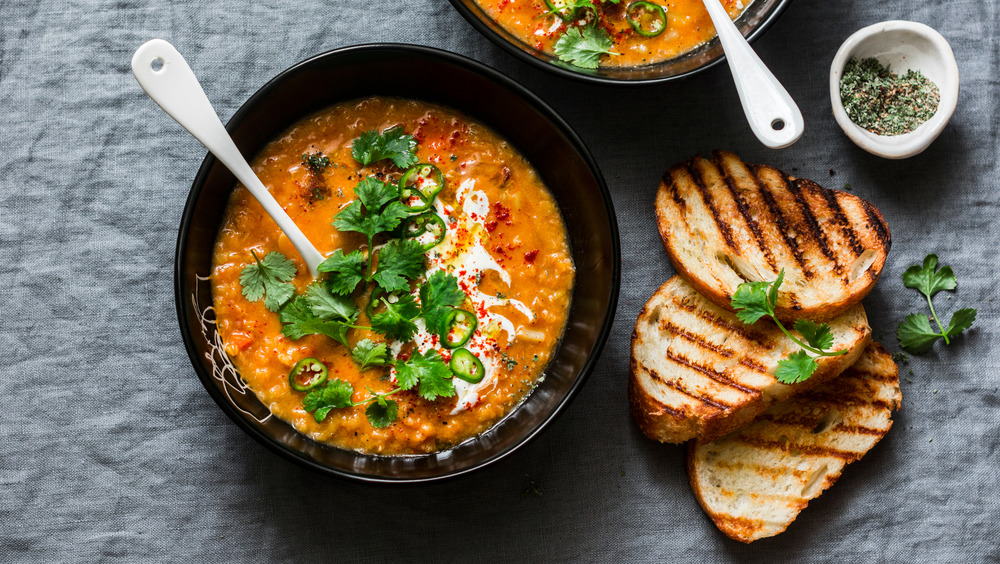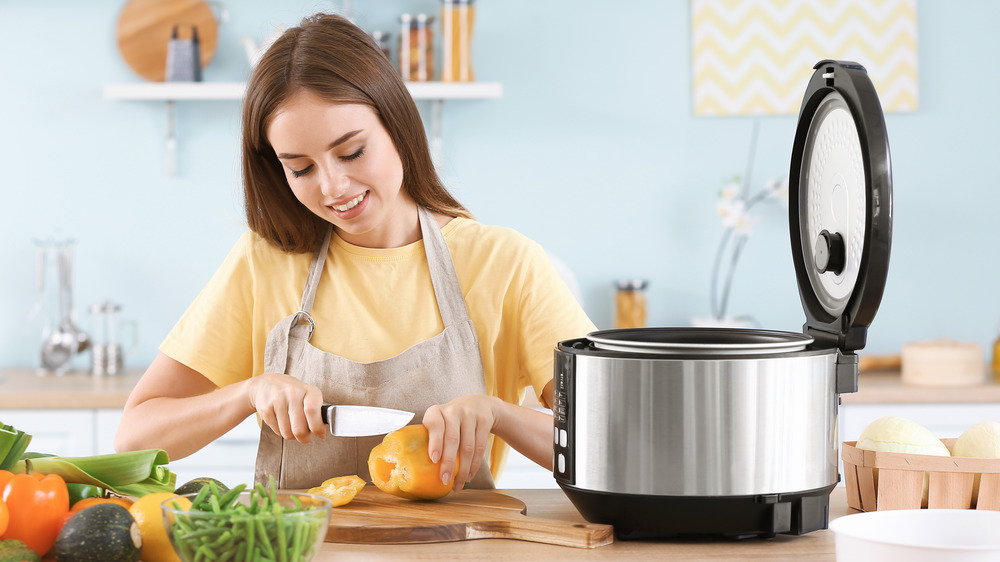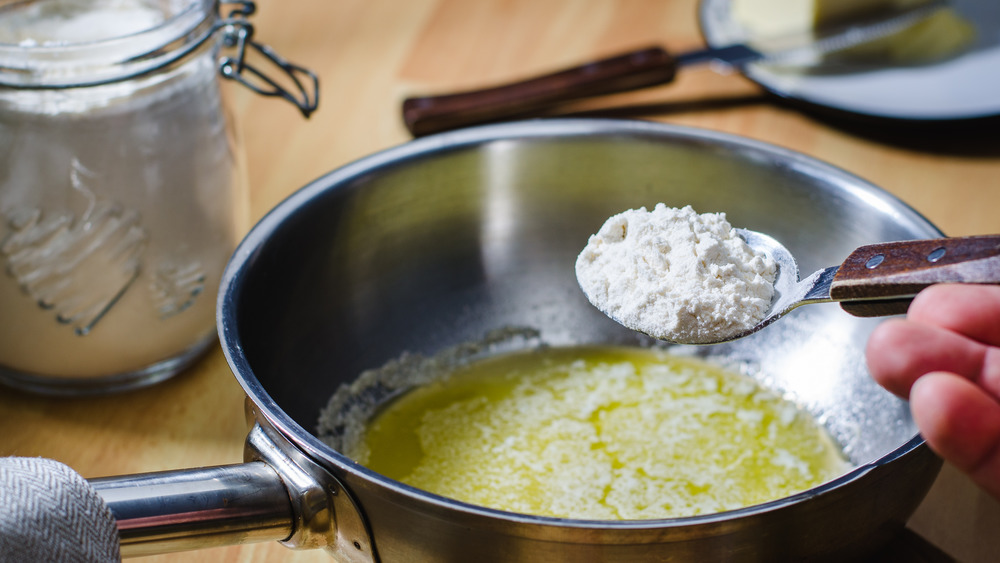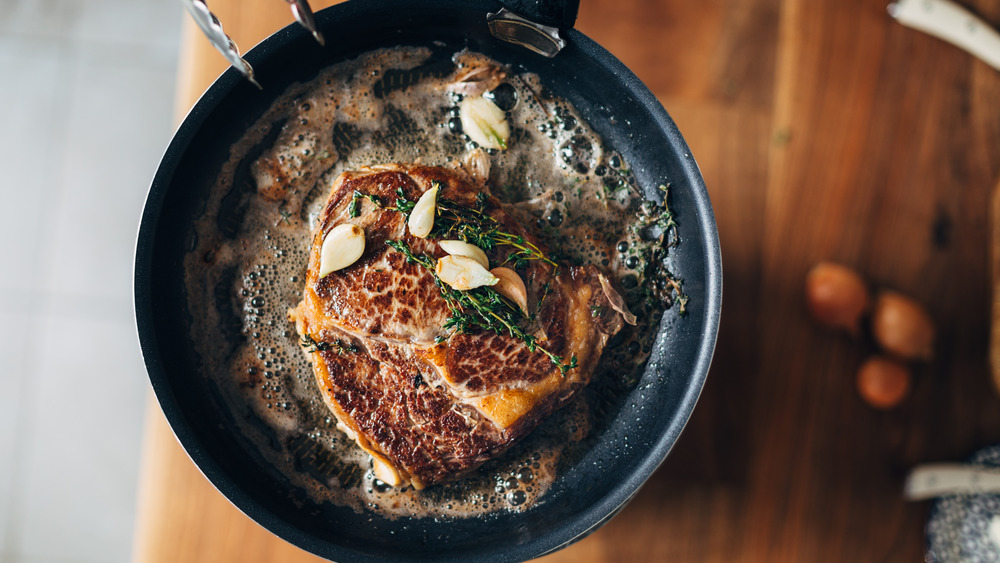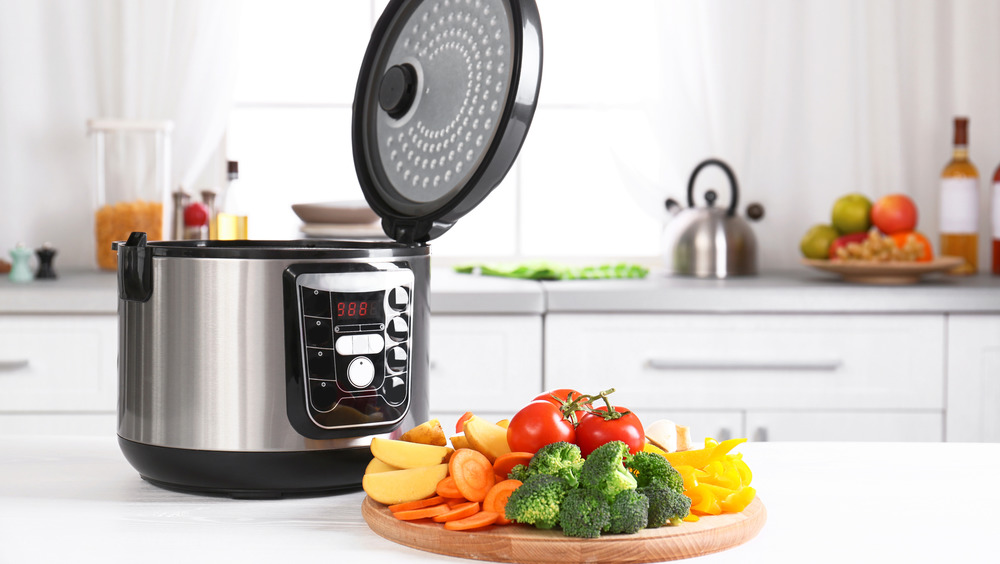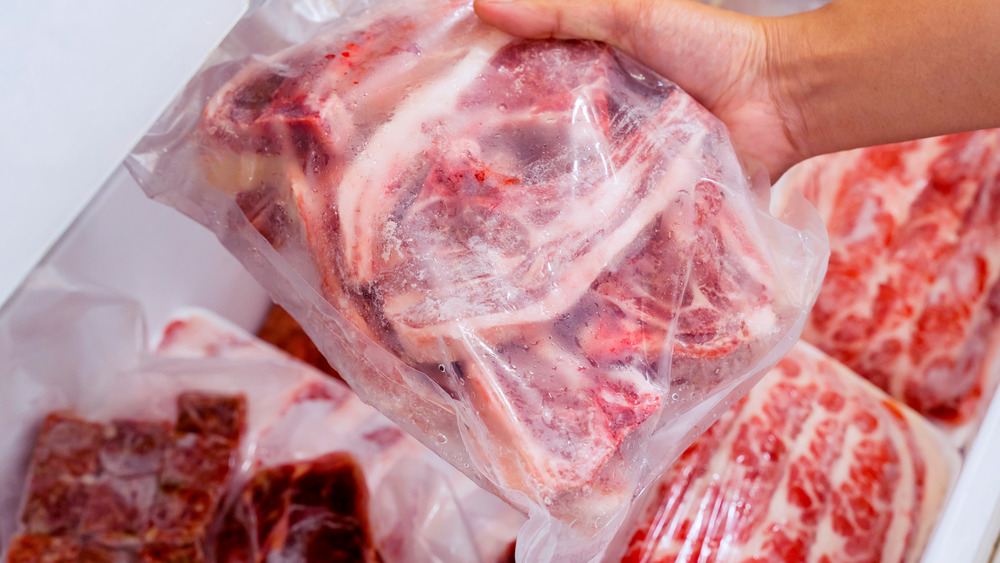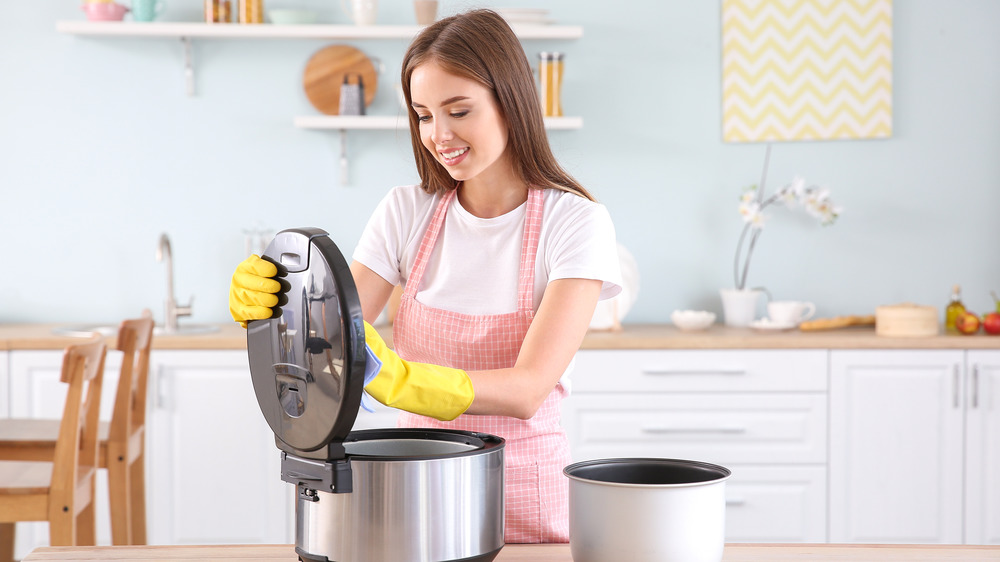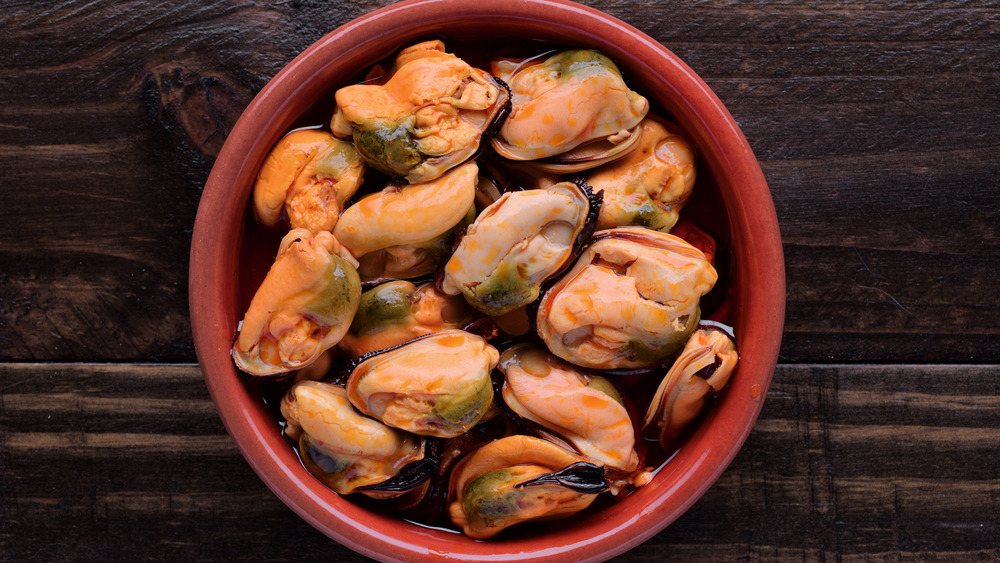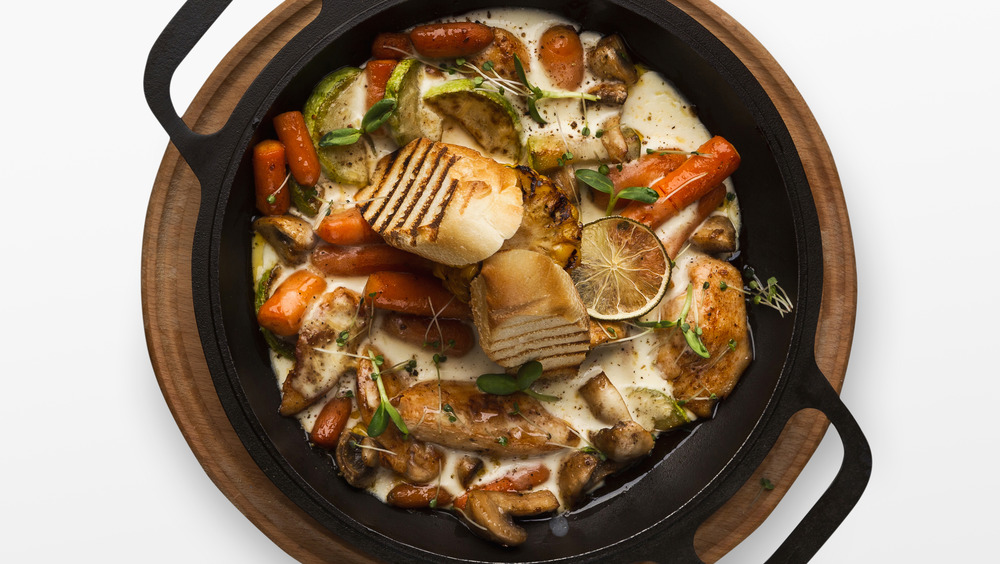Myths About Slow Cookers You Need To Stop Believing
Slow cookers are beloved for many for their ability to "set it and forget it." These gadgets are especially great for busy families, as ingredients can be dumped into a slow cooker in the morning, with a hot dinner ready and waiting when you come home at the end of the day. Slow cookers are hailed for making your life easier, and for good cause.
But, as with practically any cooking device or method, there are good and bad ways to use slow cookers. There are also a fair amount of myths about the right way to use a slow cooker. It can all get pretty confusing, pretty fast. Do you need to brown meat first? Is it only good for hearty soups and stews? What's the deal with liners? It seems easy to get tangled up in the myths and misconceptions out there that focus on this culinary workhorse, to the point where you might want to skip the slow cooker entirely.
The truth is, many of those myths are based on misunderstandings of how slow cookers work. Honestly, most everything will turn out just fine if you go into the slow cooker process with a bit of planning! Slow cookers can make hearty, delicious meals and lots of leftovers, to boot. Even better, it can do all of that pretty easily and with minimal cleanup. What's not to love about that? So, it's time to finally discard these myths about slow cookers and get cooking.
Slow cooker meals lack flavor
Many home cooks may mistakenly believe that cooking meals in a slow cooker, as opposed to doing the same in an oven, will result in less flavor. That's believed by folks for several reasons, from perceived difficulty of salting and seasoning such a big pot of food, to an inexperienced home cook throwing a whole mix of random, raw ingredients into a pot all at once and expecting it to magically blend together after a long cook time. While all that is true to some degree, avoiding these common pitfalls is actually pretty easy. Making a meal in a slow cooker can still be full of flavor if you know how to adapt to the specific method that a slow cooker offers.
The top of the list for cooking in a slow cooker is learning how to layer tastes so that every part of the food will have flavor when it's done cooking. "The process of layering flavors is the same in the slow cooker [as in other cooking methods]," says Jane McKay, co-creator of Zen of Slow Cooking. That involves "softening onions and garlic before cooking, adding herbs and spices, browning meat all count." Yes, this may add just a little extra effort, but even a few minutes spent doing something like sautéing aromatics will pay out major flavor dividends later. Also, don't be afraid to season or occasionally taste your slow cooker meal when possible, as that will help you course correct when necessary.
Slow cookers are only good for certain cuts of meat
Slow cookers are often used in recipes for hearty roasts. And have no doubt that this classic use of a slow cooker is well-earned, but that's not all these cooking tools can do for you! In fact, a slow cooker can be very useful to you even if you do not include any meat at all.
"The slow cooker is a boon for vegetarians and vegans because it is great at cooking dried beans and lentils dishes fuss free," says McKay. Beans, which normally have to be soaked overnight and then cooked for an agonizingly long time on the stove, can just be thrown in a slow cooker. Left to cook low and slow all day long with some salt and seasonings, beans can be ready for dinner whenever you are.
It is true that slow cookers are good for fattier, tougher cuts of meat, because the extended cooking time will help tough meats to become more tender. However, you'll also love it for leaner cuts of meat, along with everything from pork to chicken. Just be sure to adjust cooking times accordingly, as lean cuts may cook faster.
Slow cookers can't handle diverse meal plans
Yes, slow cookers are great for stews and soups. Everyone probably knows that already, but you likely understand that slow cookers are more than single-purpose pieces of kitchen equipment taking up valuable storage space. So, put a stop to your worries, as there are all sorts of dishes you can make in your slow cooker. In fact, any meals that benefit from low, slow cooking will excel in this pot. So, go ahead and try that fun slow-cooked take on chicken tikka masala or whip up some creamy, utterly delicious mashed potatoes. That's only the beginning!
"From all those fancy dishes to everyday appetizers – slow cookers cater to it all," says Collin Matthews, CEO and founder of Cookwared. The slow cook pot is designed to help you prepare any dish that cooks well on low temperature and takes extended cooking time. That means everything from the creamy mac and cheese to those savory enchiladas will be perfect in there. Let your imagination run free when it comes to considering just what could be made in a slow cooker.
Slow cookers won't let you reduce liquids
There are a lot of people who still believe that slow cooking pots trap all the moisture from the food, which then waters the whole meal down. While this is true on a certain level, it's not necessarily as bad as most people assume, nor is it even something that you always want to avoid!
"You can still thicken your soup or gravy in the crockpot by adding a bit of cornstarch or by cooking your meal without the lid for 20 to 30 minutes," says Matthews. This will help you to achieve your preferred consistency and give the dish enough time to thicken up to the perfect sauce state. Conversely, that extra liquid can also keep a soup or sauce from over-thickening.
Remember, meat and vegetables often give off a lot of liquid while cooking, and because of the lid, it won't evaporate away like it might in a pot or pan. If you happen to add too much liquid, it can be reduced by cooking on high without the lid for a while. Just remember to keep an eye on it towards the end to make sure the result is to your liking. You can also simply prop up the lid with a chopstick or a wooden spoon. That too will help to reduce some of the liquid in the pot.
You need to brown your meat before placing it in a slow cooker
One of the biggest myths about slow cooking is that you must brown your meat first. "I'm a big proponent of searing a roast before cooking (no matter what cooking method you're using), as it does add flavor," says cookbook author Kristy Bernardo of The Wicked Noodle. But this step is also one that you can skip if you're short on time!
When deciding whether to take the time to brown something before slow cooking, consider the other ingredients in the dish. Are they very flavorful, such as spicy enchiladas or a tomato and feta sauce? "If the flavors are more mild and you need every opportunity to build flavor, take the time to brown the meat, [but] otherwise feel free to skip it," says Bernardo.
Slow cooking is a moist heat method of cooking, so meat does not brown easily. "Meat can be browned on the stovetop or under the broiler before or after cooking to achieve a caramelized, browned exterior," says Hamilton Beach's Consumer Test Kitchen Manager, Pat Schweitzer.
Keep in mind that browning after cooking will dry the meat out more. Browning beforehand will shorten the cooking time, as can changing up some settings. "If it is a stove-top safe cookware or a slow cooker that has a brown/sear function in the base, it will shorten the time even more because the cookware and the meat are already heated," says Schweitzer.
You shouldn't open the lid when using a slow cooker
Another myth that some people believe is that you should never open the lid when slow cooking. It makes sense, since this is a mistake that can happen with your oven, perhaps while baking a cake. Slow cookers aren't quite so finicky, however. "While you should try to avoid it as much as possible to avoid heat loss, opening it quickly to check the dish won't slow the cooking process down enough that it makes much difference," says Bernardo.
If you are going to be opening the lid mid-cooking, just try your best to do it quickly and when it's necessary. "I'll even remove the lid entirely toward the end of cooking once the meat and/or vegetables are cooked to my liking," says Bernardo.
Sometimes, you might even want to take the lid off on purpose. Leaving the lid off towards the end of a cook time will allow the dish to continue gently cooking and thicken slightly, especially if it's set on high. Once the dish is perfect, change the temperature to keep it warm and replace the lid until you're ready to serve.
You can't add frozen meat to your slow cooker
Adding frozen meat to a slow cooker is actually perfectly fine. "Just make sure you use a digital meat thermometer to check the meat's internal temperature if you are worried about thoroughly cooking the meat," says Jessica Randhawa, the head chef, recipe creator, photographer, and writer behind The Forked Spoon.
That's a smart move regardless of cooking method, as the USDA recommends checking all meat and seafood internal temperatures with a thermometer before consumption to prevent foodborne illness. "I always have a digital thermometer handy for all my cooking, including slow cooking, to ensure that the internal temperature is perfect for the recipe I am making," says Randhawa.
Keep in mind that leaner cuts of meat, such as pork or chicken, will cook faster than fattier, tougher meats, like those roasts. That's because a chicken breast doesn't have a lot of connective tissue and fat. So if you are dealing with a bunch of diced up chicken and want to cook it all day, you may want to use fresh meat rather than frozen, simply to avoid overcooking your meal. However, with beef, using frozen meat is often a good way to go. It's also a great time saver if you already have meat waiting in the freezer and decide that you want to toss it in the slow cooker before you leave for work. For many cuts, there's no real reason to wait for it to defrost!
Slow cookers are hard to clean
Turns out, cleaning a slow cooking isn't at all difficult. First, there's the ease of cleaning the liner, which comes in many varieties of slow cooker. But even without the liners, the slow cooker is no harder to clean than any other type of pot. In many cases, the lids and inserts of the slow cooker are actually dishwasher safe. To clean them, just toss these parts in the dishwasher when you are done with them, though take a minute with your manual to double-check that they are, in fact, dishwasher-safe. It doesn't get much easier than that.
Don't have a dishwasher? Have you, perhaps, allowed a bit of food crud to build up on the inside and it's proving difficult to scrub by hand? An easy alternative to clean a slow cooker is to just fill it up with water and let it "cook" for a few hours. This will help to loosen any burnt or stuck-on foods. Baking soda or vinegar can also help with the cleaning process. Those same ingredients can also help save other burnt pots and pans, while you're at it.
While you're cooking or preparing to cook, it's also helpful to spray the insert of the slow cooker with nonstick cooking spray, much like you might do with a pot or pan. This helps for easy cleanup afterwards, avoiding the mess of stuck-on food in the first place.
It's bad to fill up the slow cooker
There's no real reason not to use the majority of your slow cooker's volume when making a meal. "Our recommendation is that the slow cooker cookware needs to be at least half full and is best at two-thirds full," says Hamilton Beach's Consumer Test Kitchen Manager, Pat Schweitzer.
Some worry that, if they overfill a slow cooker, this will increase cooking time and lead to less flavorful food. But it's actually not a problem. In fact, if you've only filled your slow cooker halfway, you might want to check for doneness 1 to 2 hours earlier than the recipe specifies, as the food is likely cooking faster than you might think. Of course, that's fine if you are on top of it and giving the slow cooker a little extra attention towards the end of the cook process.
If cooking soups or stews, remember to leave a two-inch space between the top of the cookware and food itself. That way, the recipe has room to come to a simmer without making a mess on your counter.
Ultimately, any portion size will be fine in the slow cooker if you adapt for it. The right amount of food in the slow cooker provides the perfect environment for heat to circulate and to braise or simmer at a steady temperature, so just take a minute and decide what's best for your particular meal.
Slow cooker liners are not safe
Some people are worried about the idea of putting a liner in their slow cooker. For many, it looks like nothing more than a plastic bag. Will it melt? Will it burn? Also some people are nervous that plastic may contain chemicals that can seep into food and create a serious health problem or two. After all, we know we shouldn't be microwaving a lot of plastics, so is this quasi-mysterious slow cooker liner okay?
The reality is that slow cooker liners have been available for quite some time and, nowadays, many are free of harmful chemicals like BPA (via Family Freezer). Many slow cooker users find that liners help them to save a lot of time in cleanup. People who use them often do so because they are easy, affordable, and make cleaning up a snap. Of course, you'll want to take a minute to read over any details concerning your liner in the slow cooker manual. "Be sure to follow the manufacturer's directions for the liners," says Schweitzer. This almost certainly means you won't want to use a liner on a cooktop or under a broiler, even if the rest of your slow cooker is okay for oven or stovetop use.
